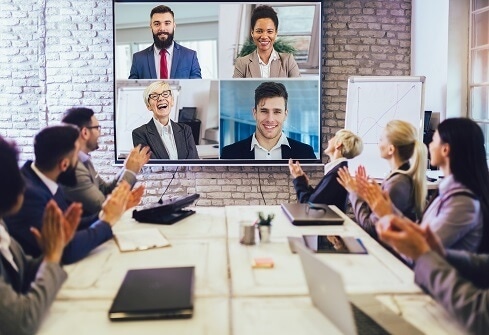Redefining the Hybrid Workplace for Experience Parity
It’s time for companies to abandon the old hybrid “here vs. there” model and engage in purposeful conversations to successfully integrate physical and online workspaces across the business.

Many companies were forced to secure the proper tools to enable remote work in 2020 (or earlier, in some cases). From health care providers upgrading to a new electronic medical record system to financial services firms conducting investor updates via video, most industries have benefited from -- if not survived -- the pandemic thanks to digital innovation. Leadership teams across the globe have been relentlessly reminded of technology’s critical role in achieving business outcomes for the past two years.
But what is needed to thrive?
The question emerges as employers opting for a hybrid model find themselves playing catch-up as they try to offer an equitable in-office experience. Common oversights -- including neglect in accurately projecting the required bandwidth to support video conferencing and other collaboration tools -- are causing frequent connectivity issues. In some cases, outdated hardware, software, and integrations cannot support a hybrid meeting. Scenarios like these lead to poor user experience, with both on-site and remote employees feeling frustrated and resentful. Poor employee experience can lead to a domino effect, directly impacting customers’ and partners’ satisfaction.
As enterprises struggle with these challenges, chief experience officers (CXOs) are helping forward-thinking companies identify ways to create digital experience parity -- an environment that provides an equitable experience to all employees, regardless of their status as a remote, hybrid or on-site worker. While investing in the proper technology and tools is important, organizations must shift their mindsets around collaboration. Let’s explore the meaning of digital experience parity and keys to cultivating it within your organization.
Eliminate "Here vs. There” Mentality
The tale of two workplaces was a common narrative in pre-pandemic offices. Then, collaboration required on-site employees to move from their desks to a meeting room, and team members working off site would join a conference line or video call to participate.
While this approach technically fits the definition of a hybrid workplace, remote employees often received second-tier treatment: they had trouble joining in the first place only to discover the audio and/or video quality was poor, or the connection was unstable. The experience disparity allowed for in-person participants to easily dominate conversations. Employees in this pre-pandemic version of a hybrid environment commonly held a “here versus there” mentality -- i.e., we are here in the office, and they are there, working from home. This mindset inherently created a barrier to effective workplace collaboration, with one group viewed as the “other.”
In 2020, that changed. All face-to-face meetings were quickly reconfigured as phone or video calls, but businesses failed to consider how elements of an effective in-person meeting didn’t always translate to a virtual setting. There were no whiteboards, no way to interpret body language and no opportunity to fuel a spontaneous brainstorming session with a group pizza order. The combination of increased video call frequency with reduced productivity and outcomes often led to “Zoom fatigue” among workers, even though everyone was technically “together” on one screen.
Leaders can’t solve this disparity by asking, “Why can’t my company just invest in better equipment to support remote and hybrid meetings?” Instead, work toward digital experience parity to unite all workers on one playing field, rather than dividing them. Achieving experience parity in 2022 and beyond will require company leadership to first cultivate a shift in perspective around what true collaboration looks like within their organization.
To begin to shift that mindset, managers must work with their teams to identify what can be accomplished asynchronously rather than synchronously; that is, how can they collaborate on a project beyond a traditional meeting format? If a group determines a hybrid meeting is the best option, its leader can then ensure all users have access to the necessary digital collaboration tools and are trained to use them to their full benefit.
Get to Work: Identify Personalized Needs and Solutions
You can’t optimize a hybrid workplace without first identifying the existing barriers to collaboration. Before making official return-to-office plans, prioritize sitting down with your IT and business unit leaders to align on your pain points and what technology is needed to scale the existing infrastructure to support a hybrid environment.
This may include investing in upgraded individual headsets, installing AI-powered cameras in conference rooms, integrating virtual whiteboards and other visual collaboration tools, and clearly defining collaboration security and governance policies. Keep in mind, the technology isn’t the end goal, but rather a tool to help achieve the larger objective of effective collaboration. There is rarely a one-size-fits-all solution as the needs of different teams and departments vary.
Simply put, digital experience parity cannot exist unless leaders approach communication and collaboration with an intentional, experience-driven mentality. It’s time for companies to abandon the old hybrid “here vs. there” model and engage in purposeful conversations to successfully integrate physical and online workspaces across the business.
About the Author(s)
You May Also Like







